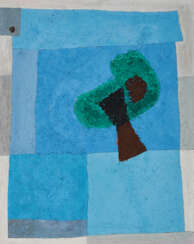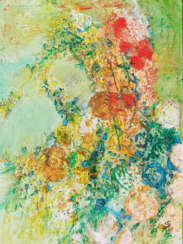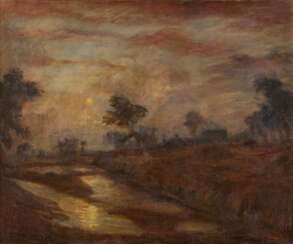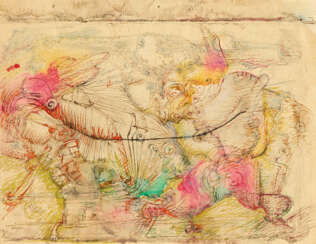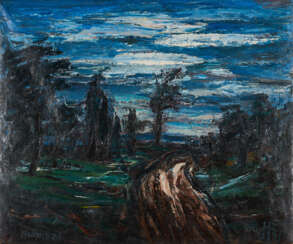природа искусства


Theo Champion was a German painter. His work was part of the painting event in the art competition at the 1928 Summer Olympics.


Franz Heckendorf was a German painter and graphic artist who was particularly successful during the Weimar Republic. During the National Socialist era, he was sentenced to ten years in prison after helping Berlin Jews threatened with deportation to extermination camps to escape to Switzerland.


Heinrich Kamps or Heinz Kamps was a German painter and director of the Düsseldorf Academy of Fine Arts.
In 1922, Kamps first presented his work to the public by participating in an exhibition of the artists' association "Das Junge Rheinland". Soon, in 1925, he was already appointed professor at the Düsseldorf Academy of Fine Arts, and four years later he took over the management of the State Art School in Berlin-Schöneberg.
During the Nazi "Degenerate Art" campaign in 1937, Kamps' works were confiscated and lost. In 1941 he was forced to leave for Austria and then Poland; in 1943 his Berlin studio was bombed by the Allies and almost all of his early works destroyed.
After the end of World War II, in 1946 Kamps was elected professor and director of the newly opened Düsseldorf Academy of Art, which he directed until his death.


Max Burchartz, full name Max Hubert Innozenz Maria Burchartz, was a German advertising photographer, designer and avant-garde artist.
Burchartz studied at the Art Academy in Düsseldorf and the Academy of Fine Arts in Munich, experimenting with Impressionism. After World War I, he resumed painting and his pictures reflected the quiet rural life of Germany but retained abstract influences.
In 1924 Burchartz devoted himself fully to the new design in typography and advertising, mixing typography, photography and photo collages. Together with Johannes Canis he founded the advertising agency werbe-bau in Bochum, and from 1926 to 1933 he taught commercial art and photography at the Volkwangschule in Essen.
Max Burchartz had a significant influence on the development of typography and advertising design in Germany. In 1928 he became a member of the board of the Society of New Advertising Designers (Ring neuer werbegestalter) and participated in the International Press Exhibition in Cologne. Burchartz also designed furniture and fittings. He is now considered a pioneer of modern design.


Theo Champion was a German painter. His work was part of the painting event in the art competition at the 1928 Summer Olympics.


Manfred Henninger was a German painter, draughtsman, graphic artist, ceramist and university lecturer. As an artist, he belongs to the lost generation.
His works often revolve around the themes of the human figure and landscape and can be described as late impressionist.
Manfred Henninger was a member of the Deutscher Künstlerbund.


Fritz Klemm was a German painter. He taught as a professor at the State Academy of Fine Arts in Karlsruhe.




Albert Birkle was a German and Austrian painter, decorator, muralist and glass painter.
Albert's father was the artist Karl Birkle, from whom he received his initial training as a decorative painter, then studied at the Hochschule für die bildenden Künste (now the Berlin University of the Arts). Birkle developed a unique style based on Expressionism and the New Objectivity/Neue Sachlichkeit style. His subjects were lonely, mystical landscapes, typical scenes of Berlin in the 20s and 30s, portraits and religious scenes.
In 1932, fleeing the National Socialists, Albert Birkle moved to Salzburg, Austria, but nevertheless represented Germany at the Venice Biennale as early as 1936. In 1937, his work was declared "degenerate" in Germany and withdrawn from state collections. In 1946, Birkle was granted Austrian citizenship and began working on religious frescoes and decorative windows for various churches and oil paintings. The 1950s and 60s were filled with intense creativity in glass painting.


Franz Heckendorf was a German painter and graphic artist who was particularly successful during the Weimar Republic. During the National Socialist era, he was sentenced to ten years in prison after helping Berlin Jews threatened with deportation to extermination camps to escape to Switzerland.


Friedrich Wilhelm Otto Modersohn was a German painter of the late 19th and first half of the 20th centuries. He is known as a landscape painter, a representative of the Barbizon School.
Otto Modersohn produced Barbizonian-style landscapes early in his career, but from about 1890 his style became more expressionist, with an emphasis on his choice of colors. The death of his second wife influenced his style: the colors became darker and the images more stark. Modersohn was one of the founders of the Worpswede artists' colony. A large collection of his works is kept in the Modersohn Museum in Fischerhude, and a street in Berlin is also named after him.


Friedrich Wilhelm Otto Modersohn was a German painter of the late 19th and first half of the 20th centuries. He is known as a landscape painter, a representative of the Barbizon School.
Otto Modersohn produced Barbizonian-style landscapes early in his career, but from about 1890 his style became more expressionist, with an emphasis on his choice of colors. The death of his second wife influenced his style: the colors became darker and the images more stark. Modersohn was one of the founders of the Worpswede artists' colony. A large collection of his works is kept in the Modersohn Museum in Fischerhude, and a street in Berlin is also named after him.


Friedrich Wilhelm Otto Modersohn was a German painter of the late 19th and first half of the 20th centuries. He is known as a landscape painter, a representative of the Barbizon School.
Otto Modersohn produced Barbizonian-style landscapes early in his career, but from about 1890 his style became more expressionist, with an emphasis on his choice of colors. The death of his second wife influenced his style: the colors became darker and the images more stark. Modersohn was one of the founders of the Worpswede artists' colony. A large collection of his works is kept in the Modersohn Museum in Fischerhude, and a street in Berlin is also named after him.


Friedrich Wilhelm Otto Modersohn was a German painter of the late 19th and first half of the 20th centuries. He is known as a landscape painter, a representative of the Barbizon School.
Otto Modersohn produced Barbizonian-style landscapes early in his career, but from about 1890 his style became more expressionist, with an emphasis on his choice of colors. The death of his second wife influenced his style: the colors became darker and the images more stark. Modersohn was one of the founders of the Worpswede artists' colony. A large collection of his works is kept in the Modersohn Museum in Fischerhude, and a street in Berlin is also named after him.










Holmead, born Clifford Holmead Phillips, was a painter. From about 1920 he joined various artist colonies in New England. In 1923, some of his paintings were shown for the first time as part of an Art Association exhibition. They were delicate, airy idylls, traditional landscapes in a brittle, silvery light, lonely farmhouses and trees. But he found the painting practiced there to be too beautiful and looked for new inspiration. In Paris, seeing a work by the French Expressionist and Fauvist Maurice de Vlaminck caused a fundamental change in his view of art. Vlaminck's dynamic lines and strong colors impressed Clifford Holmead Phillips so much that he increasingly followed the expressive direction, but later defined his style as "Crude Expressionism". From the 1920s to 1940, he celebrated international success and exhibited in important galleries and museums on both continents.

![Жирар де Пропиак, К.Ж.Ф. Достопамятности в мире, или Описание существующих на Земле редких произведений природы и искуства [в 4 т.] / Изд. г. Пропиаком.; пер. с фр.; с картинами.](/assets/image/picture_1905685/02329/o74zmsiz-2cey4zu42nc3lptthxqyp3mad75g8vo2as0u-z9g-jtmzbhgunvsdw71639497058jpg__fix_374_244.jpeg)
![Жирар де Пропиак, К.Ж.Ф. Достопамятности в мире, или Описание существующих на Земле редких произведений природы и искуства [в 4 т.] / Изд. г. Пропиаком.; пер. с фр.; с картинами.](https://veryimportantlot.com/assets/image/picture_1905685/02329/o74zmsiz-2cey4zu42nc3lptthxqyp3mad75g8vo2as0u-z9g-jtmzbhgunvsdw71639497058jpg__fix_374_244.jpeg)














